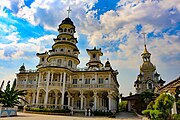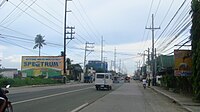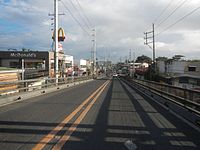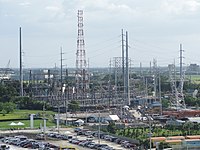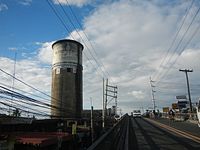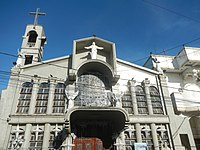Bocaue
This article needs additional citations for verification. (November 2022) |
Bocaue
Bokawe | |
|---|---|
| Municipality of Bocaue | |
From the top, left to right: Shrine of Saint Andrew Kim, Bocaue Municipal Hall, Saint Martin of Tours Parish Church, Philippine Arena | |
| Nickname: Fireworks Capital of the Philippines | |
 Map of Bulacan with Bocaue highlighted | |
Location within the Philippines | |
| Coordinates: 14°48′N 120°56′E / 14.8°N 120.93°E | |
| Country | Philippines |
| Region | Central Luzon |
| Province | Bulacan |
| District | 5th district |
| Founded | 1582 (as a barrio of Meycauayan) |
| Chartered | April 11, 1606 (as an independent town)[1][2] |
| Annexation to Bigaa | October 8, 1903 |
| Restored | November 20, 1903 |
| Founded by |
|
| Barangays | 19 (see Barangays) |
| Government | |
| • Type | Sangguniang Bayan |
| • Mayor | Eduardo J. Villanueva Jr. |
| • Vice Mayor | Sherwin N. Tugna |
| • Representative | Ambrosio C. Cruz Jr. |
| • Municipal Council | Members |
| • Electorate | 77,091 voters (2022) |
| Area | |
• Total | 31.87 km2 (12.31 sq mi) |
| Elevation | 9.0 m (29.5 ft) |
| Highest elevation | 40 m (130 ft) |
| Lowest elevation | −4 m (−13 ft) |
| Population (2020 census)[5] | |
• Total | 141,412 |
| • Density | 4,400/km2 (11,000/sq mi) |
| • Households | 34,682 |
| Demonyms |
|
| Economy | |
| • Income class | 1st municipal income class |
| • Poverty incidence | 15.13 |
| • Revenue | ₱ 596.3 million (2022) |
| • Assets | ₱ 697.2 million (2022) |
| • Expenditure | ₱ 475.7 million (2022) |
| • Liabilities | ₱ 256.7 million (2022) |
| Utilities | |
| • Electricity | Meralco |
| Time zone | UTC+8 (PST) |
| ZIP code | 3018 |
| PSGC | |
| IDD : area code | +63 (0)44 |
| Native languages | Tagalog |
| Website | www |
Bocaue [bɔˈkawɛ], officially the Municipality of Bocaue (Tagalog: Bayan ng Bocaue), is a 1st class municipality in the province of Bulacan, Philippines. According to the 2020 census, it has a population of 141,412 people.[5]
With the continuous expansion of Metro Manila, Bocaue is part of Manila's built-up area which reaches San Ildefonso in its northernmost part. The Bocaue River runs through most of the municipality.
Among its tourist attractions are a town museum located near the municipality's center and the town's river festival celebrated on the first Sunday of every July. The river festival is in commemoration of the Holy Cross of Wawa, believed to be miraculous by the town's predominantly Roman Catholic population.
Etymology
[edit]The town's name comes from the Old Tagalog word "Bukawe", which refers to a type of long bamboo (Schyzostachyum lima).
History
[edit]Bocaue was first established by Franciscan missionaries as a barrio and visita of Meycauayan in 1582 and as a town on April 11, 1606, under the advocacy of San Martin de Tours. It was the first town to be granted independence from the old Meycauayan that was then a very large town comprising the present territories of Meycauayan City, Marilao, Santa Maria, San Jose del Monte City, Obando, and Valenzuela City.
After the Philippine–American War, the Philippine Commission was established, part of whose functions was the reorganization of Philippine municipalities and provinces. In 1903, Bulacan province reduced the number of towns from 26 to 19. The town of Balagtas merged with Bocaue, with the former serving as the seat of government from October 8 to November 20 before it was transferred to the latter.[7][8] Bocaue later regained its independence and was reestablished as a town in 1911.
During the Bocaue River Festival of July 2, 1993, around 500 people rode the "floating pagoda" for the Holy Cross of Wawa way beyond the boat's capacity and caused the boat to sink, killing more than two hundred people. Despite the lives lost, no one has been made accountable for the tragedy. This incident became known as the Bocaue Pagoda Tragedy.
On the morning of December 31, 2007, ten fireworks stores burned in Barangay Turo, causing a series of explosions within the area and injuring 7 people.[9][10][11]
Geography
[edit]Bocaue is 27 kilometers (17 mi) north-east of Manila if reached via the MacArthur Highway and is 18 kilometers (11 mi) from Malolos City. It is at the mid-southwestern portion of Bulacan. Its land area is 3,187 hectares or 31.87 km2 (12.31 sq mi).
The town is bounded on the north by the municipality of Balagtas and a portion of the municipality of Santa Maria; by the municipalities of Marilao and Obando on the south; a larger portion of Santa Maria on the east; a portion of the municipality of Bulakan on the extreme southwestern side; and a portion of Balagtas on the western side.
Bocaue is traversed by the Bocaue River, a continuation of the confluence of Santa Maria River and San Jose River and a few other minor rivers and creeks, all of which are distributaries of the Angat drainage basin. The main source of Angat River and the Angat drainage basin, as well as their distributaries, is the Sierra Madre mountain range. Along these rivers are many man-made fish ponds used for raising and farming fish like bangus and tilapia.
Bocaue, along with Balagtas, Guiguinto, and Pandi, was once known as comprising the 2nd district of Bulacan. The grouping would later be known as the 5th district of Bulacan.
Barangays
[edit]Bocaue is politically subdivided into 19 barangays. Each barangay consists of puroks and some have sitios.
| PSGC | Barangay | Population | ±% p.a. | |||
|---|---|---|---|---|---|---|
| 2020[5] | 2010[12] | |||||
| 031404001 | Antipona | 1.6% | 2,289 | 2,298 | −0.04% | |
| 031404002 | Bagumbayan | 2.5% | 3,573 | 2,187 | 5.03% | |
| 031404003 | Bambang | 5.5% | 7,830 | 9,072 | −1.46% | |
| 031404004 | Batia | 22.4% | 31,663 | 19,561 | 4.93% | |
| 031404005 | Biñang 1st | 2.5% | 3,496 | 3,465 | 0.09% | |
| 031404006 | Biñang 2nd | 1.5% | 2,072 | 2,421 | −1.54% | |
| 031404007 | Bolacan | 0.8% | 1,199 | 1,106 | 0.81% | |
| 031404008 | Bundukan | 4.8% | 6,796 | 6,668 | 0.19% | |
| 031404009 | Bunlo | 3.3% | 4,686 | 4,942 | −0.53% | |
| 031404010 | Caingin | 3.9% | 5,551 | 5,253 | 0.55% | |
| 031404011 | Duhat | 5.3% | 7,444 | 7,094 | 0.48% | |
| 031404012 | Igulot | 1.0% | 1,408 | 1,468 | −0.42% | |
| 031404013 | Lolomboy | 11.7% | 16,507 | 16,421 | 0.05% | |
| 031404014 | Poblacion | 0.3% | 405 | 786 | −6.41% | |
| 031404015 | Sulucan | 1.8% | 2,572 | 2,715 | −0.54% | |
| 031404016 | Taal | 6.1% | 8,681 | 8,520 | 0.19% | |
| 031404017 | Tambobong | 3.9% | 5,558 | 4,549 | 2.02% | |
| 031404018 | Turo | 4.3% | 6,058 | 6,000 | 0.10% | |
| 031404019 | Wakas | 1.3% | 1,887 | 1,881 | 0.03% | |
| Total | 141,412 | 106,407 | 2.88% | |||
Climate
[edit]| Climate data for Bocaue, Bulacan | |||||||||||||
|---|---|---|---|---|---|---|---|---|---|---|---|---|---|
| Month | Jan | Feb | Mar | Apr | May | Jun | Jul | Aug | Sep | Oct | Nov | Dec | Year |
| Mean daily maximum °C (°F) | 29 (84) |
30 (86) |
32 (90) |
34 (93) |
33 (91) |
31 (88) |
30 (86) |
29 (84) |
29 (84) |
30 (86) |
30 (86) |
29 (84) |
31 (87) |
| Mean daily minimum °C (°F) | 20 (68) |
20 (68) |
21 (70) |
23 (73) |
24 (75) |
25 (77) |
24 (75) |
24 (75) |
24 (75) |
23 (73) |
22 (72) |
21 (70) |
23 (73) |
| Average precipitation mm (inches) | 7 (0.3) |
7 (0.3) |
9 (0.4) |
21 (0.8) |
101 (4.0) |
152 (6.0) |
188 (7.4) |
170 (6.7) |
159 (6.3) |
115 (4.5) |
47 (1.9) |
29 (1.1) |
1,005 (39.7) |
| Average rainy days | 3.3 | 3.5 | 11.1 | 8.1 | 18.9 | 23.5 | 26.4 | 25.5 | 24.5 | 19.6 | 10.4 | 6.4 | 181.2 |
| Source: Meteoblue[13] | |||||||||||||
Demographics
[edit]| Year | Pop. | ±% p.a. |
|---|---|---|
| 1903 | 8,438 | — |
| 1918 | 8,749 | +0.24% |
| 1939 | 12,345 | +1.65% |
| 1948 | 16,537 | +3.30% |
| 1960 | 22,417 | +2.57% |
| 1970 | 33,953 | +4.23% |
| 1975 | 40,577 | +3.64% |
| 1980 | 49,693 | +4.14% |
| 1990 | 67,243 | +3.07% |
| 1995 | 69,718 | +0.68% |
| 2000 | 86,994 | +4.86% |
| 2007 | 105,817 | +2.74% |
| 2010 | 106,407 | +0.20% |
| 2015 | 119,675 | +2.26% |
| 2020 | 141,412 | +3.34% |
| Source: Philippine Statistics Authority[14][12][15][16] | ||
In the 2020 census, the population of Bocaue, Bulacan, was 141,412 people, with a density of 4,400 inhabitants per square kilometer or 11,000 inhabitants per square mile.[5]
Religion
[edit]-
The new church building complex at the Shrine of Saint Andrew Kim in Barangay Lolomboy
The St Martin of Tours Church of Bocaue, otherwise known as The Diocesan Shrine of Bocaue, is one of the oldest churches in the province of Bulacan. The reputed Mahal na Krus ng Wawa (Beloved Holy Cross of Wawa) is kept here.
The Feast of the Holy Cross of Wawa is a festival held on the first Sunday of July, observed in honor of the Holy Cross of Wawa (Mahal na Krus sa Wawa), a relic believed to have saved the life of an old woman drowning in the Bocaue River. The main feature of this fiesta is the Pagoda, a gaily decorated structure riding on a huge bangka, which glides along the town river carrying people from all walks of life.
Other religious denominations in the town include Iglesia ni Cristo, Jehovah's Witness, Methodist, Aglipayan, Adventist, Baptist, and the Church of Jesus Christ of Latter-day Saints. There are also a number of Evangelical, Pentecostal, Members Church of God International and Charismatic churches, ministries, fellowships, and groups in the municipality. Muslims are also found in the municipality.
Economy
[edit]Poverty incidence of Bocaue
5
10
15
20
2006
4.00 2009
3.40 2012
4.21 2015
7.69 2018
7.52 2021
15.13 Source: Philippine Statistics Authority[17][18][19][20][21][22][23][24] |


Bocaue's town center is 27 kilometers north of Manila if reached via the North Luzon Expressway (NLEX) and the Bocaue Exit (in Barangay Turo). NLEX provides fast transport to Metro Manila from where it begins at Mabalacat, Pampanga, and Bocaue is the expressway's middle route.
The town's major industry is fireworks-making, which has earned it the tag "Fireworks Capital of the Philippines". Among the prominent firecracker stores in Bocaue is Eat Bulaga Fireworks, owned by fireworks maker Rommel Eustaquio and named after Eat Bulaga!, the longest-running noontime variety program in the Philippines.[25]
Tourism
[edit]In November 2024, Senator Joel Villanueva, Vice Mayor Sherwin Tugna and National Commission for Culture and the Arts Executive Director Eric Zerrudo led the groundbreaking and time capsule laying for a P45- million Bocaue Museum and Cultural Hub at the 18th century Casa de Municipal de Bocaue which will feature a performance arts center and history hub.[26]
Notable natives
[edit]Nationally known Bocaueños in the arts include choreographer Francisca Reyes Aquino, TV actress Jewel Mische, and contemporary painter Noli Principe Manalang. Lauro Delgado, a former veteran character actor of Premiere Productions from the early 1950s to the late 1970s, was born in Barangay Bunducan.[27]
Sports and recreation
[edit]
The Philippine Stadium, also known as the New Era University Stadium, is a sports stadium located inside the Ciudad de Victoria, a 75-hectare tourism enterprise zone located in the towns of Bocaue and Santa Maria, Bulacan. With a capacity of up to 25,000, it became the biggest stadium in the Philippines upon its completion.

The Philippine Arena, an indoor multi-purpose arena and the centerpiece of Ciudad de Victoria, is located just adjacent to the Philippine Stadium. With a seating capacity of 55,000 it became the largest indoor arena in the world upon its completion in 2014.
Education
[edit]
Bocaue is also an education center for the Meycauayan, Marilao, Santa Maria, and Balagtas municipalities area. The state-owned Bulacan Polytechnic College has a campus in Bocaue. Private colleges and universities include the Dr. Yanga's Colleges and Jesus Is Lord Colleges Foundation Inc. New Era University and St. Paul University Quezon City also established branch campuses in the municipality. The municipality also has several elementary and secondary schools, both public and private.
Government
[edit]Local government
[edit]
Sangguniang Bayan (2022–2025)
| Mayor | Party |
|---|---|
| Eduardo J. Villanueva, Jr. | NUP |
| Vice Mayor | Party |
| Sherwin N. Tugna | NUP |
Municipal Councilors:
| Councilors | Party |
|---|---|
| Alvin Paul S. Cotaco | NUP |
| Mirasol B. Bautista | NUP |
| Yboyh G. Del Rosario Sr. | NUP |
| Norielito E. German | NUP |
| Francis Jerome G. Reyes | NUP |
| Donnabel M. Celestino | Independent |
| Aristotle L. Nieto | NUP |
| Jerome P. Dela Cruz | NUP |
Mayors of Bocaue
[edit]- Mariano Ramirez (1900)
- Gregorio de la Cruz (1901-1902)
- Vicente L. Enriquez (1902-1904)
- Victor Pascual (1904-1905)
- Lorenzo Galvez (1905-1907)
- Mariano Reyes (1908-1909)
- Dionisio Morales (1910-1912)
- Victor Pascual (1913-1916)
- Honorato Ramirez (1916-1919)
- Emiliano Eusebio (1919-1922)
- Guillermo Mendoza (1922-1928)
- Dominador L. Santos (1928-1933)
- Gregorio de Guzman (1934-1935)
- Emiliano Eusebio (1935-1937)
- Dominador L. Santos (1938-1940)
- Dioscoro M. Juan, Sr. (1940-1941)
- Manolito Vistan (1942-1944)
- Joaquin San Juan (1944)
- Dioscoro M. Juan, Sr. (1945-1948)
- Moises E. Nicolas (1948-1952)
- Evangelino Mendoza (1952-1956)
- Dioscoro M. Juan, Sr. (1956-1960)
- Moises E. Nicolas (1960-1965)
- Simeon Mauricio (1965-1972)
- Matias B. Ramirez (1972-1979)
- Zacarias G. del Rosario (1979-1986)
- Ranulfo David (1986)
- Cesar N. Nicolas (1987-1988)
- Lorenzo P. Gonzales (1988-1992)
- Serafin M. de la Cruz (1992-1999)
- Jose D.G. Santiago, Sr. (1999-2001)
- Eduardo J. Villanueva, Jr. (2001-2004)
- Serafin M. de la Cruz (2004-2007)
- Eduardo J. Villanueva, Jr. (2007-2016)
- Eleanor J. Villanueva-Tugna (June 30, 2016 – May 28, 2020)[28][29]
- Jose C. Santiago, Jr. (Acting mayor May 28, 2020-June 1, 2020, June 1, 2020 – June 30, 2022)[30][31]
- Eduardo J. Villanueva, Jr. (2022–present)
Vice Mayors of Bocaue
[edit]- Moises E. Nicolas (1956–1958)
- Cesar N. Nicolas (1986–1988)
- Serafin M. de la Cruz (1988-1992)
- Mario Mendoza (1992-1995)
- Antonio Mendoza (1995–1998)
- Rogelio Ramos (1998–2001)
- Peter Christopher Gonzales (2001–2004)
- Kennedy Valdez (2004–2007)
- Jose C. Santiago, Jr. (2007–2013)
- Dioscoro Juan, Jr. (2013–2016)
- Aldrin B. Sta. Ana (2016–2019)
- Jose C. Santiago, Jr. (2019–2020)
- Alvin Paul S.P. Cotaco (2020–2022)
- Sherwin N. Tugna (2022–present)
Notable personalities
[edit]- Francisca Reyes Aquino - choreographer and National Artist of the Philippines for Dance
- Lauro Delgado - actor
- Billy Mamaril - basketball player
- Jonjon Mendoza - 32nd Governor of Bulacan and former Bulacan 3rd district representative
- Eddie Villanueva - evangelist and president-founder of Jesus Is Lord Church Worldwide; CIBAC party-list representative; and father of incumbent Philippine senator Emmanuel ("Joel"), incumbent Bocaue mayor Eduardo Jr. ("Jon-Jon") and former Bocaue mayor Eleanor ("Joni")
- Joel Villanueva - incumbent Philippine senator
Gallery
[edit]-
The Bocaue Toll Barrier of the NLEX.
-
A fragment of the Bocaue fireworks shopping strip along MacArthur Highway.
-
A part of the MacArthur Highway cutting across Barangay Lolomboy, Bocaue leading to Marilao.
-
View from MacArthur Highway's Bocaue flyover.
-
The Meralco Duhat Substation at Duhat, Bocaue.
-
The NAWASA Bocaue Water District's watertower.
-
From the town's poblacion, this is the west end of the Fortunato Halili Avenue that leads to Barangay Turo (where the town's main fireworks shopping strip is located) and the old Bocaue exit to the NLEX. The avenue also leads to the town of Santa Maria and San Jose del Monte City.
-
Saint Peter of Alcantara Parish Church, Barangay Taal.
-
A daytime view of the Philippine Arena in Ciudad de Victoria, Bocaue.
-
Another view of the Philippine Sports Stadium in Ciudad de Victoria, Bocaue.
-
St. Andrew Kim Parish Church, Barangay Lolomboy
-
Bocaue Museum and Cultural Hub site (18th century Casa de Municipal de Bocaue)
See also
[edit]References
[edit]- ^ "Proclamation No. 1268, s. 2007". Official Gazette of the Republic of the Philippines. April 10, 2007. Archived from the original on April 24, 2019. Retrieved October 11, 2019.
- ^ "Bocaue plans theme park, pyro village". The Philippine Star. Archived from the original on February 5, 2019. Retrieved February 4, 2019.
- ^ Municipality of Bocaue | (DILG)
- ^ "2015 Census of Population, Report No. 3 – Population, Land Area, and Population Density" (PDF). Philippine Statistics Authority. Quezon City, Philippines. August 2016. ISSN 0117-1453. Archived (PDF) from the original on May 25, 2021. Retrieved July 16, 2021.
- ^ a b c d Census of Population (2020). "Region III (Central Luzon)". Total Population by Province, City, Municipality and Barangay. Philippine Statistics Authority. Retrieved July 8, 2021.
- ^ "PSA Releases the 2021 City and Municipal Level Poverty Estimates". Philippine Statistics Authority. April 2, 2024. Retrieved April 28, 2024.
- ^ Act No. 932 (October 8, 1903), "An Act Reducing the Twenty-five Municipalities of the Province of Bulacan to Thirteen", Senate of the Philippines Legislative Digital Resources, archived from the original on October 21, 2023, retrieved July 3, 2023
- ^ Act No. 1002 (November 20, 1903), "An Act Amending; Act Numbered Nine Hundred and Thirty-two, Entitled "an Act Reducing the Twenty-five Municipalities of the Province of Bulacan to Thirteen."", Senate of the Philippines Legislative Digital Resources, archived from the original on October 21, 2023, retrieved July 3, 2023
- ^ "Bulacan, Philippines: Bocaue, Bulacan: History". www.bulacan.gov.ph. Archived from the original on September 25, 2021. Retrieved August 9, 2021.
- ^ Limos, Mario Alvaro (December 27, 2019). "The History of How Bulacan Became the Country's Fireworks Mecca". Esquiremag.ph. Archived from the original on August 9, 2021. Retrieved August 9, 2021.
- ^ "Bocaue remembers 1993 pagoda tragedy". Rappler. Archived from the original on July 9, 2021. Retrieved August 9, 2021.
- ^ a b Census of Population and Housing (2010). "Region III (Central Luzon)" (PDF). Total Population by Province, City, Municipality and Barangay. National Statistics Office. Retrieved June 29, 2016.
- ^ "Bocaue: Average Temperatures and Rainfall". Meteoblue. Archived from the original on March 23, 2022. Retrieved May 12, 2020.
- ^ Census of Population (2015). "Region III (Central Luzon)". Total Population by Province, City, Municipality and Barangay. Philippine Statistics Authority. Retrieved June 20, 2016.
- ^ Censuses of Population (1903–2007). "Region III (Central Luzon)". Table 1. Population Enumerated in Various Censuses by Province/Highly Urbanized City: 1903 to 2007. National Statistics Office.
- ^ "Province of Bulacan". Municipality Population Data. Local Water Utilities Administration Research Division. Retrieved December 17, 2016.
- ^ "Poverty incidence (PI):". Philippine Statistics Authority. Retrieved December 28, 2020.
- ^ "Estimation of Local Poverty in the Philippines" (PDF). Philippine Statistics Authority. November 29, 2005.
- ^ "2003 City and Municipal Level Poverty Estimates" (PDF). Philippine Statistics Authority. March 23, 2009.
- ^ "City and Municipal Level Poverty Estimates; 2006 and 2009" (PDF). Philippine Statistics Authority. August 3, 2012.
- ^ "2012 Municipal and City Level Poverty Estimates" (PDF). Philippine Statistics Authority. May 31, 2016.
- ^ "Municipal and City Level Small Area Poverty Estimates; 2009, 2012 and 2015". Philippine Statistics Authority. July 10, 2019.
- ^ "PSA Releases the 2018 Municipal and City Level Poverty Estimates". Philippine Statistics Authority. December 15, 2021. Retrieved January 22, 2022.
- ^ "PSA Releases the 2021 City and Municipal Level Poverty Estimates". Philippine Statistics Authority. April 2, 2024. Retrieved April 28, 2024.
- ^ "Aldub helps sales of firecrackers sour". Philippine Daily Inquirer. December 29, 2015. Archived from the original on December 29, 2015. Retrieved December 30, 2015.
- ^ Silverio, Frederick (November 25, 2024). "P45-M museum, cultural hub to rise in Bocaue". The Manila Times. Retrieved November 25, 2024.
- ^ "March 9, 1899, Francisca Reyes-Aquino was born in Lolomboy, Bocaue, Bulacan". The Kahimyang Project. November 12, 2013. Archived from the original on August 9, 2021. Retrieved August 9, 2021.
- ^ "Bocaue, Bulacan Mayor Joni Villanueva dies". GMA News. May 28, 2020. Archived from the original on June 10, 2020. Retrieved May 28, 2020.
- ^ "Bocaue, Bulacan Mayor Joni Villanueva dies". GMA News. Archived from the original on June 10, 2020. Retrieved May 28, 2020.
- ^ "Happening today is the oath taking of Jose C. Santiago, Jr. as the new Municipal Mayor of Bocaue, Bulacan. This is to fill-up the vacancy left by the late Mayor Eleanor J. Villanueva-Tugna. | DILG-Bulacan". facebook.com. June 1, 2020. Archived from the original on October 21, 2023. Retrieved June 1, 2020.
- ^ "Happening today is the oath taking of Jose C. Santiago, Jr. as the new Municipal Mayor of Bocaue, Bulacan. This is to fill-up the vacancy left by the late Mayor Eleanor J. Villanueva-Tugna". facebook.com. Archived from the original on October 21, 2023. Retrieved June 1, 2020.









